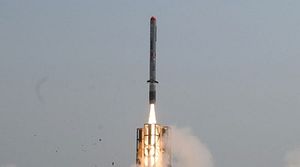The Indian Ministry of Defense’s (MoD) Defense Research and Development Organization (DRDO) today conducted the sixth flight test of the nuclear-capable Nirbhay cruise missile, India’s first indigenously designed and developed long-range cruise missile, from the Integrated Test Range on Abdul Kalam Island off the coast of Odisha.
“It is the sixth development flight trial with objective to prove the repeatability of boost phase, cruise phase using way point navigation at very low altitudes,” the MoD said in a statement. “The missile took off vertically turning horizontally into desired direction, booster separated, wing deployed, engine started, cruised all the intended waypoints [all sic].”
Cruising at 0.7 Mach at altitude as low as 100 meters, the test reportedly validated the missile’s sea-skimming capability. “The entire flight was fully tracked by a chain of Electro Optical Tracking Systems, Radars and Ground Telemetry Systems deployed all along the sea coast,” the MoD said. The Nirbhay cruise missile purportedly covered the designated target range in 42 minutes and 23 seconds.
According to the MoD, all test objectives were met.
The Nirbhay is a subsonic long-range land attack cruise missile that can be armed with a 200-300-kilogram warhead. The nuclear-capable, solid fuel, missile can reportedly reach top speeds of 0.6-0.7 Mach and can strike land targets at a distance of up to 1,000 kilometers. It can be launched from multiple platforms — the first test of the air-launched variant is expected to take place in 2021 — and reportedly has loitering capability.
The last successful test launch of the Nirbhay missile took place in November 2017. A previous test launch in December 2016 ended in failure with the missile destroyed in mid-air after it deviated from its course. As I noted in February:
Two other test launches also ended in failure, with only one other flight trial, conducted in October 2014, declared a success. DRDO engineers have pointed to problems with the flight control software and navigation system of the Nirbhay, as well as hardware design flaws, for the causes of the failed missile tests.
According to an official of India’s Aeronautical Development Establishment (ADE) speaking to media in February, software and hardware issues that hampered the missile’s performance during tests in the past have now been addressed.
Nirbhay missiles used in past tests were all powered by Russian-made NPO Saturn 36MT mini turbofan engines. The DRDO has been working on the indigenously designed and developed Manik turbofan engine. “The Manik engine should be ready for testing in two years,” the head of DRDO, S. Christopher, was quoted as saying by Indian media. “By the time user trials begin, we hope to be in a position to offer Manik-powered Nirbhay, at which point the system will be over 95 percent indigenous.”
( A previous Diplomat report claiming that the missile prototype launched in April will carry the Manik turbofan engine has apparently proven to be incorrect.)
The MoD considered terminating the Nirbhay program on numerous occasions in the past. Next to technical and funding difficulties, there remains a lingering question over the Indian military’s operational requirement for a subsonic, long-range cruise missile.
Despite of that, the Nirbhay program has reportedly been given priority status by the MoD.
Notably, DRDO is working on an extended-range air-launched variant of the BrahMos supersonic cruise missile, designated BrahMos-ER, with an estimated strike range of around 800 kilometers.































